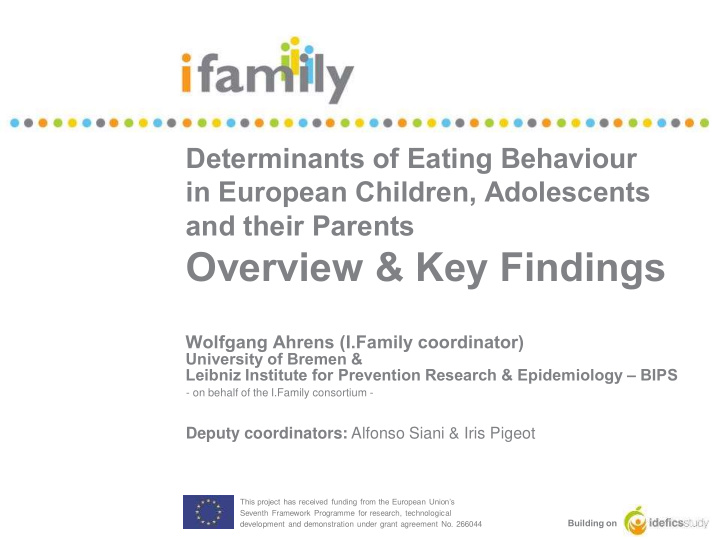



Determinants of Eating Behaviour in European Children, Adolescents and their Parents Overview & Key Findings Wolfgang Ahrens (I.Family coordinator) University of Bremen & Leibniz Institute for Prevention Research & Epidemiology – BIPS - on behalf of the I.Family consortium - Deputy coordinators: Alfonso Siani & Iris Pigeot This project has received funding from the European Union’s Seventh Framework Programme for research, technological Building on development and demonstration under grant agreement No. 266044
Aim: contribute to reducing burden of nutrition-related diseases • Understand interplay between barriers and main drivers of a healthy food choice • Identify predictors of unnecessary weight gain and cardio-metabolic risk by linking them to diet, physical activity and interacting factors • Focus on child and his / her family • Assess how different factors affect children as they grow up • Develop and convey strategies to induce changes towards a healthy behaviour Funded by the EC, FP 7, Project No. 266044 - Building on
Partners 1. Strovolos, Cyprus 2. Ghent, Belgium 3. Copenhagen, Denmark 4. Tallin, Estonia 5. Helsinki, Finland 6. Bremen, Germany 7. Pécs, Hungary 8. Avellino, Italy 9. Milan, Italy 10. Utrecht, Netherlands 11. Palma de Mallorca, Spain 12. Zaragoza, Spain 13. Gothenburg, Sweden 14. Bristol, United Kingdom 15. Lancaster, United Kingdom 16. Andover, United Kingdom Funded by the EC, FP 7, Project No. 266044 - Building on
Timeline of recruitment and follow-up IDEFICS – I.Family cohort, starting with 2-10 year olds 2006 2007 2008 2009 2010 2011 2012 2013 2014 2015 2016 2017 Community Baseline Follow-up 1 Follow-up 2 Contrasting intervention groups 16,228 13,596 9,617 children children children Transition: Transition: Transition: toddler child child adolescent adolescent adult Funded by the EC, FP 7, Project No. 266044 - Building on
Questionnaires & examinations 1 Questionnaires (parent + child) Social factors, lifestyle, peers + physical activity Food frequency, preference, eating behaviour Medical history Family members + household 24-hour dietary recall Web-based dietary recall Physical activity Accelerometer: 7 days Built environment: GIS + GPS Funded by the EC, FP 7, Project No. 266044 - Building on
Questionnaires & examinations 2 Physical examinations Anthropometry + blood pressure Bone health: ultrasound Biological markers Blood, saliva + urine Specific tests in subgroups Sensory taste perception Neuropsychological tests: impulsivity Brain mechanisms of food choice: fMRI Funded by the EC, FP 7, Project No. 266044 - Building on
Prevalence of childhood overweight/obesity (2-10 yr) Funded by the EC, FP 7, Project No. 266044 - Building on
Dietary behaviour • Children with low socio-economic background • Persistently unhealthier dietary profiles over a 2-year period • Dietary patterns rich in fruits & vegetables, wholemeal cereals, and low in animal products • Lower risk of overweight/obesity • Less 2-year weight gain Funded by the EC, FP 7, Project No. 266044 - Building on
Sleep and weight status • Short sleep duration being overweight – particularly in primary school children • Inverse relationship between sleep duration and BMI mainly explained by inverse association between sleep duration & fat mass • Insulin may explain part of this association, in particular in heavier children Funded by the EC, FP 7, Project No. 266044 - Building on
Physical activity (PA) and overweight (OW) Causality goes both ways Few children meet physical activity guidelines (60min MVPA/day) Higher or increasing fat mass decline in MVPA Just 10 minutes more MVPA per day prevent excess weight gain MVPA = Moderate to Vigorous Physical Activity Funded by the EC, FP 7, Project No. 266044 - Building on
Built environment and physical activity Physical activity-friendliness of the built environment (“ moveability ”) more MVPA of 596 primary school children in the German study region Playground density and density of playgrounds and parks combined positive effects on MVPA MVPA = Moderate to Vigorous Physical Activity Funded by the EC, FP 7, Project No. 266044 - Building on
Media consumption • TV exposure preference for sugary/fatty foods followed by higher consumption of sugar-sweetened beverages increased risk of overweight/obesity • One-third of children exceeded screen time recommendations (max. 2h/day) • Exceeding sedentary guidelines increased risk of high blood pressure • Watching TV during meals , having a TV in the child’s bedroom and watching TV more than 1h/day being overweight/obese Funded by the EC, FP 7, Project No. 266044 - Building on
Swimming upstream The causes of obesity – and the causes of the causes Environments Behaviours Physiology Family & individual factors Systems Environments Behaviour Energy patterns imbalance Policy & economic Food supply & Social & economic status, Diet, physical Also role of systems promote marketing promote schooling & childcare, activity, sleep, genetics, chemical consumption high energy intake family structure, stigma etc stress coping, etc exposures, etc Policy interventions Drugs, surgery Community interventions, social marketing Population effect & political difficulty Adapted from: Swinburn et al. The global obesity pandemic: shaped by global drivers and local environments. Lancet. 2011; 378: 804-14 Funded by the EC, FP 7, Project No. 266044 - Building on
“Childhood obesity undermines WHO 2016 the physical, social and psychological wellbeing of children and is a known risk factor for adult obesity and non- communicable diseases. There is an urgent need to act now to improve the health of this generation and the next.” Funded by the EC, FP 7, Project No. 266044 - Building on
E NDING C HILDHOOD O BESITY – strategic objectives No single intervention can halt the rise of the growing obesity epidemic. To successfully challenge childhood obesity requires • addressing the obesogenic environment • as well as critical elements in the life-course. Funded by the EC, FP 7, Project No. 266044 - Building on
Thank you! Funded by the EC, FP 7, Project No. 266044 - Building on
Recommend
More recommend